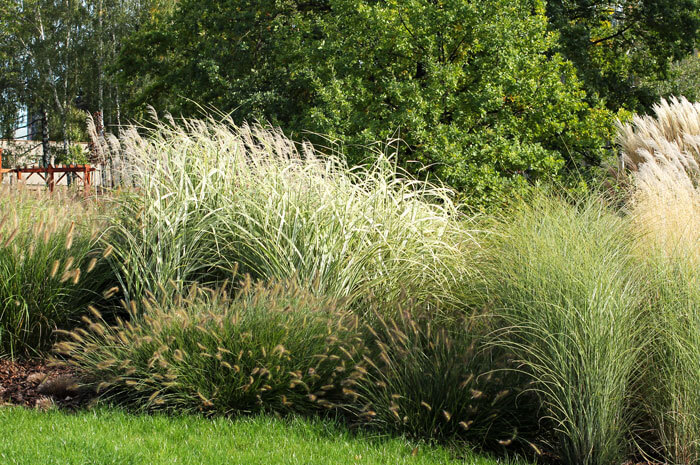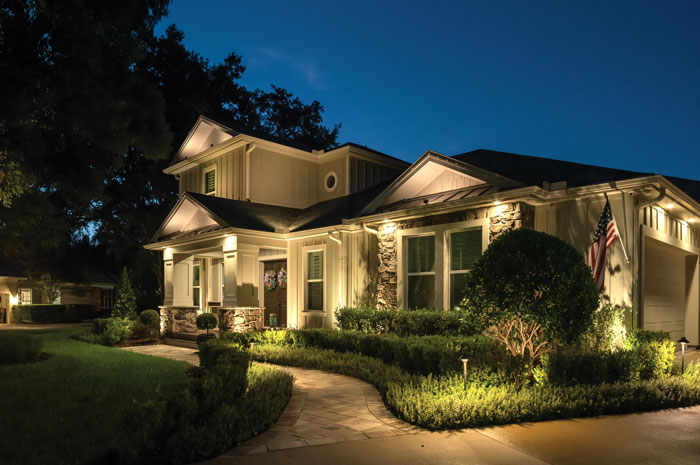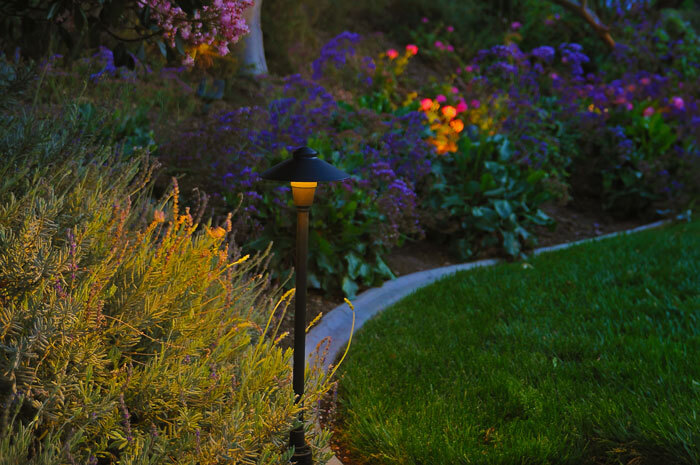
Ornamental grass is growing in popularity. It’s not difficult to see why. It’s hardy. It makes a visual impact. It provides shelter and food to local wildlife.
What is ornamental grass? It’s not the short stuff that we work so hard to keep green all year round. Ornamental grass comes in a variety of shades and sizes, ranging from 10 feet tall to just grazing ankle height. It’s been curated from all over the world and is native to the United States. Used in landscaping, hardscaping, and even potted to add greenery to patios, it’s one of the most versatile plant options out there. Want to learn more? We’ll go over a few details to consider before you choose to plant an ornamental grass and after that we’ll cover the minimal care required to keep decorative grass thriving.
Before You Grow: Choosing What Ornamental Grasses to Plant
Maybe you already have some ornamental grass in your landscaping, if that’s the case, feel free to skip a few sections to where we cover ornamental grass care specifics. However, if you heard about how easy and beautiful decorative grass is then stick around to learn more about picking the right ornamental grass for you.
Do Ornamental Grasses Spread?
Yes, many species of ornamental grass will spread. Ornamental grasses are easy to grow, some would say too easy. Just because you can picture a beautiful style of grass in your landscaping doesn’t mean you want it popping up all over your yard. Some grasses spread using aggressive rhizomes, an underground method of spreading that makes it difficult to effectively weed strays.
When you’re choosing your ornamental grass it’s important to know how it grows and if its seeds will spread not only to your yard but throughout the neighborhood. There are two kinds of grass growing patterns: clump-forming and runners. Runners are just how they sound. A great choice for filling a large swath of landscaping, this style of ornamental grass spreads easily.
Clump-forming grasses tend to stay in a neat mound. Less aggressive, you can turn your back on these grasses without worrying about them taking over landscaping or spreading into your yard.
Fast Growing Ornamental Grass
Runners aren’t always a bad thing. If you’re trying to fill out a spot with low maintenance plants that make a pretty impact, runner grasses are a great choice. As a bonus, runners are typically taller and more dramatic than their neat clump-forming cousins. Grasses known to be quick runners are Blue Lyme Grass, Prairie Cordgrass and Ribbongrass.
You may want to be careful where you plant fast-growing grasses. Not only can non-native grasses take over your landscaping but they can often spread beyond your property, choking out native plants and showing invasive tendencies. If you want a fast-growing grass that’s tolerant to everything from drought to flooding, consider planting native varieties of grasses.
Slow Growing Ornamental Grasses
Ornamental grass care is easiest when you don’t have to trim it back and weed stragglers all the time. If you want that’ll leave your landscaping and your local flora unscathed, then clumping varieties of grasses are the way to go. Many varieties of clump-forming grass also stay short, letting you plant your grass without needing to trim the grass through the growing season. Expanding over time, these grasses will fill out a space without taking over. Fountain grass, maiden grass, and switchgrass are 3 popular varieties of clump-forming grasses.
What ornamental grasses look good together?
When you’re pairing ornamental grasses, it’s important to think about contrasts. Surround tall grasses with short, clump-forming grasses. Pair grasses with showy catkins with grasses with pointy grasses with attitude. Contrasting colors ensure that your grasses will remain interesting long after your flowers have wilted.
What is the Easiest Ornamental Grass to Grow in Your Climate?
When it comes to climate, there are two main categories of grasses: warm and cool-season grasses. Growing in zone 3 to eleven, warm-season grasses are the easiest type to grow. Don’t be fooled by the name. They can be grown in cold regions but they thrive best in 80-90 degree weather.
The reason these grasses are easier to grow than cool-season grasses comes down to one simple fact, warm season ornamental grasses are more drought tolerant than cool season grasses. Popular drought-resistant grasses include anything from the less-than-showy native Bluestem to flamboyant, towering Pampas grass.
Caring for Ornamental Grass
Now that you know more about what grass will work well for your project, it’s time to move on to the relatively simple ornamental grass care needs. Once established, most ornamental grasses don’t need regular watering or fertilizer. Most grasses will need to be groomed once a year.
Depending on the species of grass, your main duty in caring for decorative grasses might be making sure some grasses don’t escape your landscaping and take over the neighborhood. Be sure and plant clump-forming grasses if you need to keep your grass in a smaller area. Some clump-forming grasses will still try to spread by sending out underground rhizomes but you’ll be able to turn your back without coming back to a full-blown ornamental grass takeover.
Annual Ornamental Grass Care
Decorative grasses don’t need a lot of care but they do need to be groomed in order to keep them disease free and looking fresh. Most of this maintenance will take place in the spring, after the grass begins to grow again.
When to Cut Back Ornamental Grasses
There are three main types of grasses with different growing patterns. Evergreen grasses will grow all year round, though they’ll slow down in mid-winter. Warm-season grasses don’t begin growing until late spring. Cool-season grasses start growing in the spring before the temperature reaches 75 degrees.
Long ornamental grasses are often valued throughout the winter for their ability to provide seasonal interest and habitat to animals; however those that live in climates with wet winters or where fire is a concern may decide to do their cutting back in the late fall.
Warm weather grasses will turn brown in the winter but refraining from cutting the grass down will provide winter interest in the snow and offer seeds to local wildlife. Cool-weather grasses may continue to grow throughout mild winters.
The long and short of it? Most ornamental grasses should be cut back to a height of 6 to 10 inches in the early spring before growth begins.
How to Cut Back Ornamental Grasses
Before you start, put on thick gloves and eye protection. Long grass can be surprisingly sharp. Make cutting bunches of grass easy and save your back by using a bungee cord and a hedge trimmer.
Circle the cord around the base of a clump of grass and slip it up to secure the grass in a nice bundle. Using a hedge trimmer, cut the grass evenly to your desired height. To make clean-up easy, toss grass clippings in a bucket or wheelbarrow to take along with you as you continue trimming.
Which Ornamental Grasses Shouldn’t Be Cut Back?
Most ornamental grasses should be cut back annually besides those of the evergreen variety. Evergreen grasses such as Fescue and Blue Oat Grass, don’t go completely dormant so they won’t need to be cut back. If evergreen ornamental grasses begin to look scruffy with dead or dying strands throughout the clumps, they should be combed out and the brown grass stems should be removed.
Combing Ornamental Grasses
Some ornamental grasses will need to be combed to remove dead and dried-up grass stems. This process is relatively simple. Using gloves to avoid sharp strands of grass, comb your fingers through the clump of grass. Shake it occasionally to dislodge any dead strands that might be hidden in the lush growth. When you find dead strands, they’ll easily pull away from the base. Toss the strands into a container you can carry along with you to avoid a big mess after you’re done grooming.
Biennial Ornamental Grass Care: Dividing
Every two or three years, clumps of ornamental grasses will be ready to be divided, giving you an opportunity to fill that empty spot in your landscaping that you’ve been eyeing. Like most ornamental grass care, dividing should be done in the early spring.
There is some variation, of course. Warm-season grasses can also be divided in mid-summer, as long as you divide the grass before it flowers. In the early fall, cool-season grasses can also be divided. Be sure to give your grass time to recover before the cold winter sets in.
How to Divide Ornamental Grass Clumps
Before you divide your grass make sure that you’re catching it while it’s actively growing but before it’s flowering. Dividing dormant grass may result in the plant failing to successfully establish a root system.
To make sure you divide your grass evenly, you’ll want to remove the whole clump of grass. Start by digging around the whole clump with a sharp-tipped shovel, circling the grasses’ roots. Cutting through some roots is to be expected. Once you’ve dug around the plant, gently lift the grass and the roots and simply set it on the ground where you have space to work.
Using a garden knife or a saw, cut down the middle of the root ball. Cut the clump into the number of segments you want making sure that each section retains some of its roots. Before you divide the whole clump of grass, remember to consider the size of the original spot and how much of the grass you want to stay in that area.
Transplanting Ornamental Grass Cuttings
Whether you’re planting your own divided grass or you got a decorative grass cutting from your neighbor, transplanting grass is relatively simple. Dig a hole twice the size of the width of the grasses’ roots. Ornamental grass doesn’t need fertilizer once but mixing the soil with compost will help the plant thrive.
Cover the grass so that its roots are covered to the base of the crown. Water the grass as soon as it’s planted and continue to water until the plant is well-rooted.
Caring for Decorative Grasses Grown in Containers
Grass is a popular choice for decorating small spaces such as patios and pools areas. Even apartment balconies look great accented with a pot of ornamental grass. Much like decorative grass grown in the ground, potted grass is also relatively easy to take care of though there are a few differences. If you live in a climate with cold winters, move your containers into a sheltered area such as a garage through the cold season. Water ornamental grass deeply every two to three weeks.
Decorative grasses can add a lot to your landscape with relatively little care required. Do you want to know more about landscaping with ornamental grasses or native plants? Check out the rest of our articles. We’re here to help with all of your landscaping interests!



